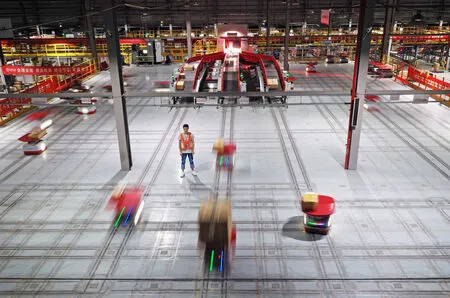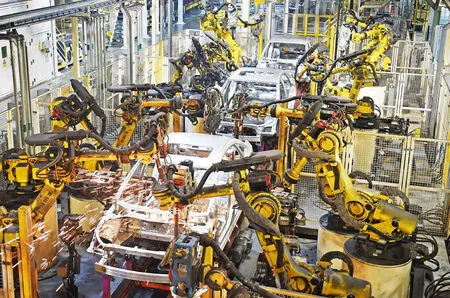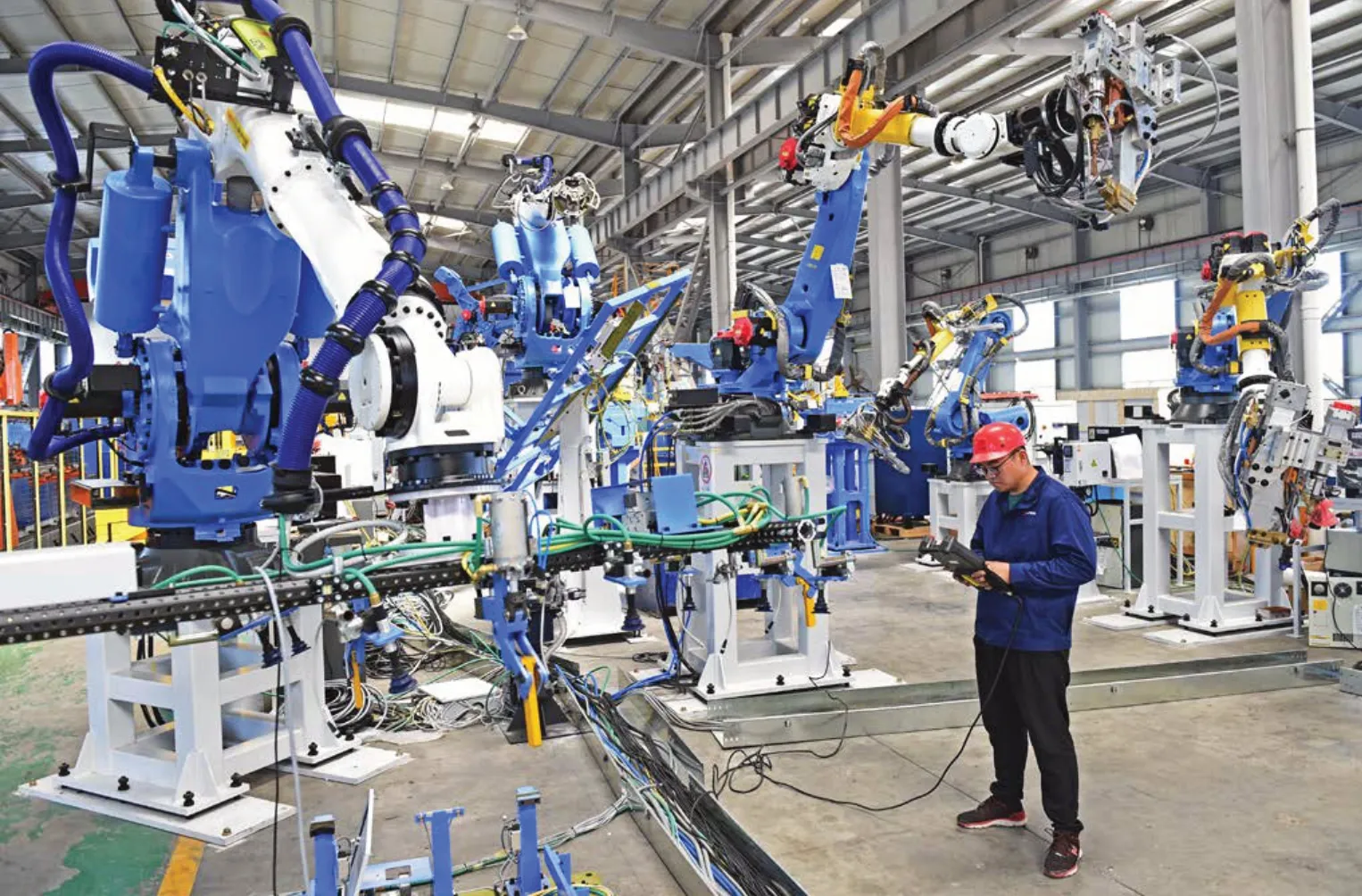From Traditional Manufacturing to Intelligent Manufacturing—A Glance of High-end Smart Factories in Hubei Province
2020-04-15TextphotosbyLiXiZhangLiheYuZhijunWuYadiHeWeiguo
Text & photos by Li Xi,Zhang Lihe,Yu Zhijun,Wu Yadi & He Weiguo

In Wuhan Transfer Center of Shunfeng Express,the sorting robot Little Red is sorting and transporting parcels orderly.顺丰速运武汉快运中转场,分拣小车“小红人”正有条不紊将快件分拣和传送。
With the in-depth interfusion between AI technology and the traditional manufacturing industry ,intelligent manufacturing is placed on the top agenda for many enterprises.
What will the future factory look like? What functions will they have? What changes will they bring to the manufacturing industry?
To answer the questions,we have visited a number of smart factories in Hubei Province and explored how the AI technologies are applied to the traditional manufacturing industry in upgrading and transforming their productive power.
Little Red Robot
Around 11 pm on September 10,2019,we arrived at Wuhan Transfer Center of Shunfeng Express on Zoumaling Street,Dongxihu District and found the automated sorting system busy sorting and transporting numerous parcels at a rapid speed in a well-lit workshop.
This station is responsible for the heavy parcels of Shunfeng Express in Wuhan,and most of the parcels weigh more than 10 kilograms.In the past,it took a large number of sorters to complete the same amount of work,but now it only needs several workers’ assistance.In the SSC robotic sorting area on the second floor,40 sorting robots,nicknamed Little Red,were transporting parcels to their designated places.
We quickly glanced at the whole process of the robots’ parcel sorting.A box with the tag of “microwave oven” was coming on the belt.After passing the infrared scanner,it fell precisely on the back of a Little Red that stood ready when the box was put on the belt.The Little Red moved along the route as programmed and followed the transportation rules.It moved straight,turned left and straight again.At the destination,the box was unloaded steadily and then slid precisely into the proper truck compartment.
We are told that the robot sorting system could handle 1300 parcels per hour,which took 30 skilled workers to do the same job in the past.It helped to save more than 60% of production cost under the same conditions.
Amazing Smart Tailor
In the past,it took seven steps to make clothes—namely,pattern drawing,pattern cutting,pattern grading,pattern marking,marker making,apparel cutting,and apparel sewing.But now in the workshop of Wuhan I’d Group Ltd.,the entire process before apparel cutting is mainly done by computers and machines.
The designer first singles out an apparel pattern stored in the computer and tapes it to the smart cloth cutter.Two minutes later,the garment pieces of sleeves,chest,and back are done.Usually the cloth-plaiting machine sends tens of folds of cloth to the smart cloth cutter,and the cutter employs an automatic laser scissor to cut the cloth into designed pieces in a short time.
The garment pieces would be categorized according to different types and specifications,and then sent to the designated tailor by the robots.The smart fetching system would then help transport the semi-finished product to the next line.
大型振动筛加强梁动态受力分析和寿命预测 卢世坤,刘初升,高 迟,王凤平,王 明,张凤翔,吕 琳1(28)

In the workshop of Wuhan I’d Group Ltd.,the intelligent cloth cutter is cutting tens of folds of cloth into a designed pattern within a few seconds through precise computing.武汉爱帝针纺实业有限公司车间,经过智能裁床的计算和切割,数十层布料在极短时间内被切成衣片。
随着人工智能技术与传统制造业的深度融合,智能制造成为众多制造工厂转型升级的必然趋势。
未来的智能工厂是什么模样?有哪些本领?它们又会给行业带来哪些变化?
这段时间,我们走访了全省各地多家智能工厂,探秘传统制造工厂转型升级背后的新技术。
奔跑的“小红人”
2019年9月10日晚11 时许,武汉市东西湖区走马岭街顺丰速运武汉快运中转场,壮观的工厂里灯火通明,琳琅满目的快件在自动化分拣设备上快速流转,令人目不暇接。
该中转场是顺丰速运在武汉的重货中转场,快件多以10 公斤以上的货物为主。在过去,重货的中转分拣是需要人海战术完成的,而这里,却没有看到太多工人。在平台二层的SSC 智能机器人分拣区,40 台分拣小车“小红人”正在场地内驮着快件满场奔跑。
记者仔细查看了一个快件经过机器人分拣的全过程:传送带上,一件印有“微波炉”字样的纸箱飞驰而来,经过一道“安检门”的红外扫描后,“小红人”从传送带下方同步出发,分秒不差,快件从传送带末端稳稳地落在了“小红人”的后背上,“小红人”驮着快件,直行,左转,前进,按照程序计算出的路线和“交通规则”,到达目的地后自动把货物平稳卸下,快件如坐滑滑梯一般,准确地流向下一区域的货车厢内。
神奇的“智能裁缝”
传统服装生产流程是:手工画版、剪出纸样、放码、排版、按纸样画唛架、裁剪、缝制。
在武汉爱帝针纺实业有限公司车间,裁剪和裁剪以前的流程都是以电脑和机器为主。
在制衣车间,设计师从电脑中调出一个服装版型,将其发送到智能裁床,两分钟后,袖子、前胸、后背等衣片就出来了。当自动码布机将数十层布料,送至智能裁床,经过电脑激光切割,数十层的衣片不一会儿就裁好了。
衣片按照不同品种和规格分类,放入货架后,机器人自动取货,送到指定裁缝工位。工位上方,智能吊挂系统自动行进,将衣服的半成品传送到相应岗位。
此前,每个裁缝以20 件衣服为一捆,做完后,起身送往下一道工序。现在,打捆、拆捆、起身等过程都省下来,效率变高。由于在一个系统上,各个工序逐渐同步起来。这样,同时在线生产的产品从50 个增加到了200 个,生产效率提高近30%。每个裁缝生产数量增长,工资也相应增加15%至20%。
In the past,the tailor needed to pack 20 clothes into a bundle,and send them to the next worker by walking.But now the machine helps eliminate the process of bundling,debundling,and walking,thus improving efficiency.All the working procedures could be performed at the same time.Meanwhile,the products made are increased from 50 to 200 per worker,improving the efficiency by a large margin.In return,every tailor’s salary is also raised by 15%-20%.
Smart “Control Brain”
On September 11,we arrived at the Industry 4.0 workshop of Soufeiya Home Collection Co.,Ltd.located in the Hi-Tech Zone of Huanggang City.In the spacious workshop,there was neither annoying noise nor stinky smells.A few workers were inspecting rows of robot arms,busy putting various forms of wooden boards on the running lathes.Starting from the smart warehouse,all the working procedures,including board cutting,edge banding,drilling,sorting and packaging,are performed by robots and through the smart logistics network system.Not a single worker is needed in this process.The system could allocate tasks dynamically,calculate the cutting precisely,and minimize the waste of boards by maximizing the utilization.

In the Industry 4.0 workshop of Suofeiya Home Collection Co.,Ltd.,robotic arms are taking the boards from the shelves and processing them automatically.索菲亚家居湖北有限公司工业4.0 车间,机械臂从周转货架上自动存取板材进行智能加工。

In the workshop of SAIC-GM Wuhan Branch,hundreds of robots are welding the BIW (Body in White).上汽通用汽车有限公司武汉分公司车身车间内,数百台机器人正对白车身进行焊接。
Lying in the center of the workshop is a see-through glass room.It is the control room of the Industry 4.0 workshop.It works like a chief engineer who has all the plans in his grasp.Likewise,the room could monitor the operation,production tasks,progress,efficiency,and other information of the whole production system and every production line in real time through three screens.
“What makes the Industry 4.0 workshop different from the traditional workshop is that it turns the once isolated workshop into a smart production line,which shortens the production cycle of every batch,speeds up the logistics,and reduces the interval between every procedure.” One manager in charge said.
The shuttling Little Red Robot,the amazing smart tailor,and smart control brain are good examples of high-end smart factories in Hubei Province.At present,by implementing the strategy of “investing 1 trillion yuan in the technological reformation of 10,000 enterprises” Hubei Province is fulfilling the opportunities brought by the interfusion of information and industrialization,and boosting the transformation and upgrading of its traditional manufacturing industry,driving itself towards a leader in the future of the smart manufacturing industry.
聪明的“中枢大脑”
9月11日,记者走进位于黄冈高新区的索菲亚家居湖北有限公司工业4.0 车间,偌大的车间里,既没有刺耳的噪声,也没有刺鼻的气味,工人寥寥无几。

In Workshop II of the HGTECH Laser Robot System Intelligent Factory,a worker is commissioning an auto body welder for a new Civic model of Dongfeng Honda.华工激光智能装备事业群2 号车间内,项目团队正在进行东风本田新款思域汽车车身焊接线体的安装调试。
一排排机械臂在忙碌地“舞蹈”,一块块造型各异的板材在车床上“奔跑”。从智能立体原料仓出发,每一块原料板件经过开料、封边、打孔、分拣、打包等工序,均由机器人和智能物流网联系统完成,全程不落地,不经人手。系统十分聪明,能实时动态地分配工作任务,对板材的开料进行精确计算,最大程度提高板材利用率,有效减少木材浪费。
车间正中央有一间透明的玻璃房子,是这个4.0 车间的“中枢大脑”。它就像运筹帷幄的总工程师一样,通过三块显示大屏,清楚地呈现着整套生产系统及每条生产线的实时运行状态、生产任务、生产进度、生产效率等信息。
“4.0 车间与普通工厂车间最大的不同,在于成功地将传统生产车间的制造孤岛联接为一条智能化生产线,大大缩短每批次板件的生产周期,加快了物流转运,减少了工序之间的等待时间。”企业负责人介绍说。
奔跑的“小红人”、神奇的“智能裁缝”、聪明的“中枢大脑”,是湖北高端智能工厂的一个个剪影。当前,湖北正深入实施“万企万亿技改工程”,抢抓两化融合发展的新机遇,助力传统制造业转型升级,加快新旧动能转换,推动制造大省向智造强省迈进。
过去10年,湖北高新技术产业增加值从2008年的1104.94 亿元上升到2018年的6653 亿元,增长5 倍多。大到新能源汽车、高端数控装备、工业机器人,小到手机、电子元器件、5G 芯片,越来越多的湖北“智造”正走向全国乃至世界。

In the workshop of Yicheng Tianshu Textile Co.,Ltd.,the digital monitor at the bottom of the spinning machine is moving back and forth and detecting the broken thrums,and the workers only need to assist the operation.宜城天舒纺织有限公司生产车间,纺纱机下方的数字化跟踪仪来回监视数万根线头是否断开,工人只需辅助操作。
In the past decade,the added revenue from the new technology industry in Hubei increased from 110.494 billion yuan in 2008 to 665.3 billion yuan in 2018,with a growth of more than five times.More and more products—such as new energy automobiles,high-end CNC equipment,industrial robots,mobile phone,electronic components,and 5G chips—manufactured in Hubei with smart technology,are sold widely throughout China and the rest of the world.(Translation:Li Li)
